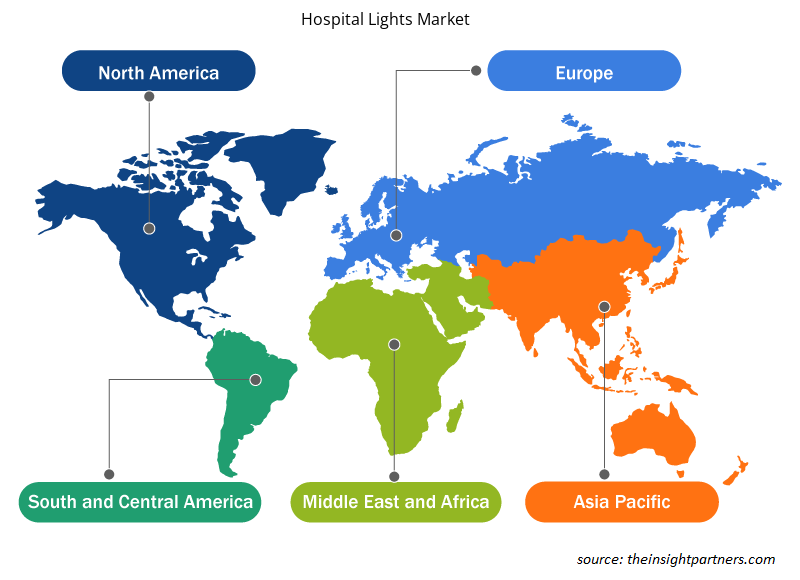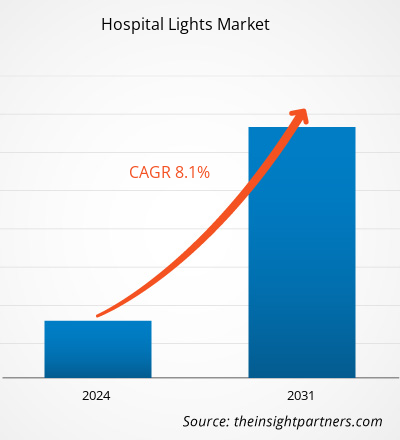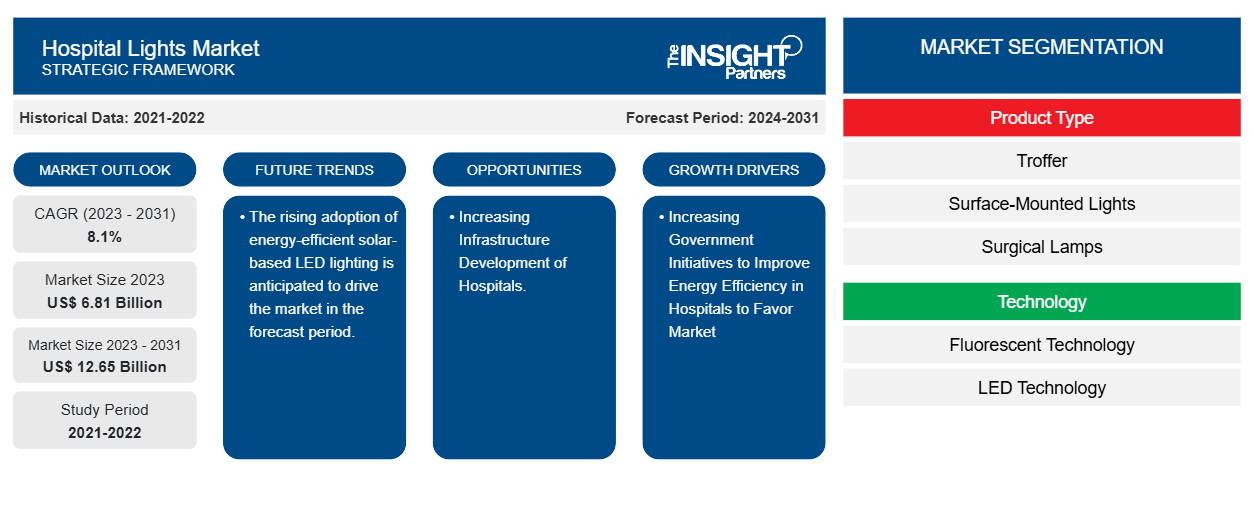Si prevede che il mercato delle luci ospedaliere raggiungerà i 12,65 miliardi di dollari entro il 2031, rispetto ai 6,81 miliardi di dollari del 2023. Si prevede che il mercato registrerà un CAGR dell'8,1% nel periodo 2023-2031. Le crescenti iniziative governative per migliorare l'efficienza energetica negli ospedali e l'elevata domanda di luci LED durante gli interventi chirurgici saranno probabilmente le tendenze chiave e i driver del mercato delle luci ospedaliere.
Analisi del mercato delle luci ospedaliere
Il mercato delle luci ospedaliere sta vivendo una crescita significativa a livello globale. Questa crescita è attribuita a fattori quali le crescenti iniziative governative per migliorare l'efficienza energetica negli ospedali e l'elevata domanda di luci LED durante gli interventi chirurgici. Inoltre, si prevede che il crescente sviluppo delle infrastrutture degli ospedali e la crescente adozione di un'illuminazione LED efficiente a energia solare offriranno diverse opportunità per il mercato delle luci ospedaliere.
Panoramica del mercato delle luci ospedaliere
L'illuminazione ospedaliera è definita come l'illuminazione artificiale di strutture sanitarie, quali cliniche, ospedali, case di cura, ecc. L'illuminazione ospedaliera può essere suddivisa in due categorie principali: illuminazione interna e illuminazione esterna.
Personalizza questo report in base alle tue esigenze
Riceverai la personalizzazione gratuita di qualsiasi report, comprese parti di questo report, o analisi a livello nazionale, pacchetto dati Excel, oltre a usufruire di grandi offerte e sconti per start-up e università
-
Scopri le principali tendenze di mercato in questo rapporto.Questo campione GRATUITO includerà analisi di dati che spaziano dalle tendenze di mercato alle stime e alle previsioni.
Driver e opportunità del mercato delle luci ospedaliere
Incrementare le iniziative governative per migliorare l'efficienza energetica negli ospedali a favore del mercato.
L'aumento delle iniziative governative per migliorare l'efficienza energetica negli ospedali stimola effettivamente la crescita del mercato a livello globale. L'illuminazione svolge un ruolo cruciale nelle strutture mediche. Non si tratta solo di fornire luce per la visibilità, l'illuminazione ospedaliera influisce sul benessere dei pazienti, sull'efficienza dei professionisti medici e sull'atmosfera generale dell'ospedale. Per questo benessere, i governi di vari paesi e le iniziative. Ad esempio, nel febbraio 2022, il governo indiano ha cercato di introdurre ospedali verdi e digitali con la missione di risparmiare energia e trasformare il settore sanitario. In questa iniziativa, il governo ha sostituito 33.000 luci convenzionali con luci a LED per migliori livelli di lux e risparmi energetici. Pertanto, considerando i fattori di cui sopra, diverse iniziative governative per migliorare l'efficienza energetica negli ospedali stanno guidando il mercato delle luci ospedaliere.
Aumento dello sviluppo delle infrastrutture degli ospedali.
Si prevede che l'aumento dello sviluppo delle infrastrutture offra diverse opportunità per il mercato delle luci ospedaliere. Man mano che l'infrastruttura dell'ospedale migliora, aumenta anche la domanda di forniture ospedaliere ed efficienza energetica. Inoltre, molti paesi sono impegnati a investire nello sviluppo delle infrastrutture ospedaliere. Ad esempio, a marzo 2024, i finanziamenti federali hanno alimentato massicci aggiornamenti delle infrastrutture sanitarie degli Stati Uniti. I sostanziali progetti imminenti di strutture mediche richiederanno diversi tipi di competenze del settore, nonché un'abbondanza di attrezzature, componenti di sicurezza e tecnologia. Pertanto, si prevede che il governo che adotta varie iniziative guiderà il mercato delle luci ospedaliere.
Analisi della segmentazione del rapporto di mercato delle luci ospedaliere
I segmenti chiave che hanno contribuito alla derivazione dell'analisi di mercato delle luci ospedaliere sono il tipo di prodotto, la tecnologia e l'applicazione.
- In base al tipo di prodotto, il mercato delle luci ospedaliere è suddiviso in troffer, luci montate in superficie, lampade chirurgiche e altre. Si prevede che il segmento troffer detenga una quota di mercato significativa nel periodo di previsione.
- In base alla tecnologia, il mercato delle luci ospedaliere è suddiviso in tecnologia fluorescente, tecnologia LED e altre. Si prevede che il segmento della tecnologia fluorescente detenga una quota di mercato significativa nel periodo di previsione.
- Per applicazione, il mercato è segmentato in reparti di degenza e UTI, sale operatorie, sale visita e altro. Si prevede che il segmento dei reparti di degenza deterrà una quota di mercato significativa nel periodo di previsione.
Analisi della quota di mercato delle luci ospedaliere per area geografica
L'ambito geografico del rapporto sul mercato delle luci ospedaliere è suddiviso principalmente in cinque regioni: Nord America, Asia Pacifico, Europa, Medio Oriente e Africa, Sud e Centro America.
Il Nord America ha dominato il mercato delle luci ospedaliere. La crescita del mercato delle luci ospedaliere sta registrando una crescita dovuta alle crescenti iniziative governative per migliorare l'efficienza energetica negli ospedali e all'elevata domanda di luci LED durante gli interventi chirurgici nella regione. Inoltre, una forte enfasi sulla ricerca e sviluppo nelle economie sviluppate degli Stati Uniti e del Canada sta costringendo i player nordamericani a portare sul mercato soluzioni tecnologicamente avanzate. Inoltre, gli Stati Uniti hanno un gran numero di player del mercato delle luci ospedaliere che si sono sempre più concentrati sullo sviluppo di soluzioni innovative. Tutti questi fattori contribuiscono alla crescita del mercato delle luci ospedaliere nella regione.
Approfondimenti regionali sul mercato delle luci ospedaliere
Le tendenze regionali e i fattori che influenzano il mercato delle luci ospedaliere durante il periodo di previsione sono stati ampiamente spiegati dagli analisti di Insight Partners. Questa sezione discute anche i segmenti e la geografia del mercato delle luci ospedaliere in Nord America, Europa, Asia Pacifico, Medio Oriente e Africa e Sud e Centro America.

- Ottieni i dati specifici regionali per il mercato delle luci ospedaliere
Ambito del rapporto di mercato sulle luci ospedaliere
| Attributo del report | Dettagli |
|---|---|
| Dimensioni del mercato nel 2023 | 6,81 miliardi di dollari USA |
| Dimensioni del mercato entro il 2031 | 12,65 miliardi di dollari USA |
| CAGR globale (2023-2031) | 8,1% |
| Dati storici | 2021-2022 |
| Periodo di previsione | 2024-2031 |
| Segmenti coperti |
Per tipo di prodotto
|
| Regioni e Paesi coperti |
America del Nord
|
| Leader di mercato e profili aziendali chiave |
|
Densità degli attori del mercato: comprendere il suo impatto sulle dinamiche aziendali
Il mercato delle luci ospedaliere sta crescendo rapidamente, spinto dalla crescente domanda degli utenti finali dovuta a fattori quali l'evoluzione delle preferenze dei consumatori, i progressi tecnologici e una maggiore consapevolezza dei vantaggi del prodotto. Con l'aumento della domanda, le aziende stanno ampliando le loro offerte, innovando per soddisfare le esigenze dei consumatori e capitalizzando sulle tendenze emergenti, il che alimenta ulteriormente la crescita del mercato.
La densità degli operatori di mercato si riferisce alla distribuzione di aziende o società che operano in un particolare mercato o settore. Indica quanti concorrenti (operatori di mercato) sono presenti in un dato spazio di mercato in relazione alle sue dimensioni o al valore di mercato totale.
Le principali aziende che operano nel mercato delle luci ospedaliere sono:
- Società per azioni Signify Holding (Philips)
- Marchio Acuity, Inc.
- Illuminazione Cree
- Società per azioni Dragerwerk AG & Co. KGaA
- Gruppo KLS Martin
- Società per azioni Stryker
Disclaimer : le aziende elencate sopra non sono classificate secondo un ordine particolare.

- Ottieni una panoramica dei principali attori del mercato delle luci ospedaliere
Notizie di mercato e sviluppi recenti sulle luci ospedaliere
Il mercato delle luci ospedaliere viene valutato raccogliendo dati qualitativi e quantitativi dopo la ricerca primaria e secondaria, che include importanti pubblicazioni aziendali, dati associativi e database. Di seguito sono elencati alcuni degli sviluppi nel mercato delle luci ospedaliere:
- Royal Philips, leader mondiale nella tecnologia sanitaria, ha annunciato una partnership strategica per integrare la soluzione avanzata di smartQare, viQtor, con le piattaforme di monitoraggio clinico dei pazienti leader a livello mondiale di Philips. Questa collaborazione mira a consentire la prossima generazione di monitoraggio continuo dei pazienti sia dentro che fuori dall'ospedale, a partire dall'Europa. (Fonte: sito Web aziendale Royal Philips, aprile 2024)
Copertura e risultati del rapporto sul mercato delle luci ospedaliere
Il rapporto "Dimensioni e previsioni del mercato delle luci ospedaliere (2021-2031)" fornisce un'analisi dettagliata del mercato che copre le seguenti aree:
- Dimensioni e previsioni del mercato delle luci ospedaliere a livello globale, regionale e nazionale per tutti i principali segmenti di mercato coperti dall'ambito
- Tendenze del mercato delle luci ospedaliere e dinamiche di mercato come driver, restrizioni e opportunità chiave
- Analisi dettagliata delle cinque forze PEST/Porter e SWOT
- Analisi di mercato delle luci ospedaliere che copre le principali tendenze del mercato, il quadro globale e regionale, i principali attori, le normative e i recenti sviluppi del mercato
- Analisi del panorama industriale e della concorrenza che copre la concentrazione del mercato, l'analisi della mappa termica, i principali attori e gli sviluppi recenti nel mercato delle luci ospedaliere
- Profili aziendali dettagliati
- Analisi storica (2 anni), anno base, previsione (7 anni) con CAGR
- Analisi PEST e SWOT
- Valore/volume delle dimensioni del mercato - Globale, Regionale, Nazionale
- Industria e panorama competitivo
- Set di dati Excel
Report recenti
Rapporti correlati
Testimonianze
Motivo dell'acquisto
- Processo decisionale informato
- Comprensione delle dinamiche di mercato
- Analisi competitiva
- Analisi dei clienti
- Previsioni di mercato
- Mitigazione del rischio
- Pianificazione strategica
- Giustificazione degli investimenti
- Identificazione dei mercati emergenti
- Miglioramento delle strategie di marketing
- Aumento dell'efficienza operativa
- Allineamento alle tendenze normative























 Ottieni un campione gratuito per - Mercato delle luci ospedaliere
Ottieni un campione gratuito per - Mercato delle luci ospedaliere